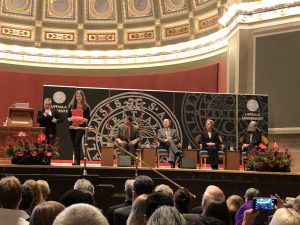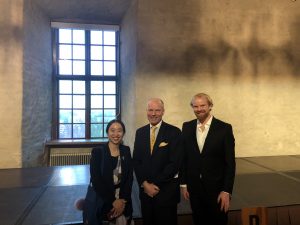- Home
- Message from Chair
- News
- Uncategorized
- IEEE Sweden at the Nobel lectures in Uppsala
IEEE Sweden at the Nobel lectures in Uppsala
On December 13th 2018, Uppsala University played host to a series of Nobel lectures, followed by a luncheon in Uppsala Castle.
The session commenced with Sofia Lindblad receiving the Swedish Chemical Society award for ‘Best Master Thesis’ in Chemistry, with congratulations from the Nobel Laureates.
The laureates then treated attendees to lectures which were in equal parts fascinating and entertaining.
The Chemistry laureates begun. Prof. George P. Smith guided participants through the principles of affinity selection from phage display libraries; portraying what can be learned from surface plasmon resonance. Prof. Sir Gregory P. Winter spoke of harnessing evolution to make medicine, building on the work of Prof Smith. He highlighted the two main approaches to new medicines, e g to cure cancer, chemical and antibodies. Of 10 top such medicines (by revenue) today, 8 are based on antibodies, the other 2 on chemicals. He then elaborated on his third alternative, a “bicycle” approach; a combination of both. These ‘engineered’ antibody treatments appear very promising, as trials on mice indicate some tumors are effectively treated in only 21 days.
Prof. Frances H. Arnold took the podium next, or rather the stage – walking freely exploring every centimeter, almost as a metaphor to her work exploring the intricacies and permutations of evolution. She engaged the auditorium comparing music composition, with evolutions innovation – bringing new chemistry to life. By mimicking and speeding up natural evolution processes, new innovative solutions could be developed – without using traditional chemical processes, a point emphasized with a playful dig at the illustrious laureates. One illustration is binding Silicon with Carbon, which does not appear in ‘mother nature’. By repetitively using a ‘synthetic’ natural evolution process, Frances and her team have developed SI – C bondings – without chemical processes etc.
Prof. Donna Strickland – one of the Laureates in Physics and the first woman in 55 years – performed a very entertaining show, on the informal topic ‘how to develop a hammer, in order to hit atoms and electrons’. To generate high-intensity ultrashort optical pulses includes substantial challenges. E.g. to amplify a short laser pulse to high energy levels is difficult due to equipment damage etc. The groundbreaking inventions in the field of laser physics include step-wise approaches: First generating an ultra short pulse, ‘prolonging it’, amplifying it using ‘chirped pulse amplification’ (CPA), then finally shortening it to a femto -second.
All of the laureates succeeded in “hitting the nail on the head” when it came to delivering lectures based in complex subjects in a manner accessible to the diverse and captivated gathered in Uppsala universities ornate auditorium.
IEEE Sweden Section was present at the lectures and the luncheon: Jiajia Chen, Associate Professor KTH, Gerard Duff, Chair IEEE Young Professionals and Mats Edvinsson, Sweden Section Board. We were grateful to get opportunities to chat with Donna Strickland, who has published many IEEE articles in e g Journal of Selected Topics in Quantum Electronics and Journal of Quantum of Electronics.
The day was rounded out with a luncheon in the opulent Uppsala castle. It was fitting that on Lucia attendees where presented to perhaps a new spark of innovation in Sofia Lindblad, and four of the shining lights in physics, chemistry and biochemistry. Hopefully leading to a bright new year in innovation and engineering.


